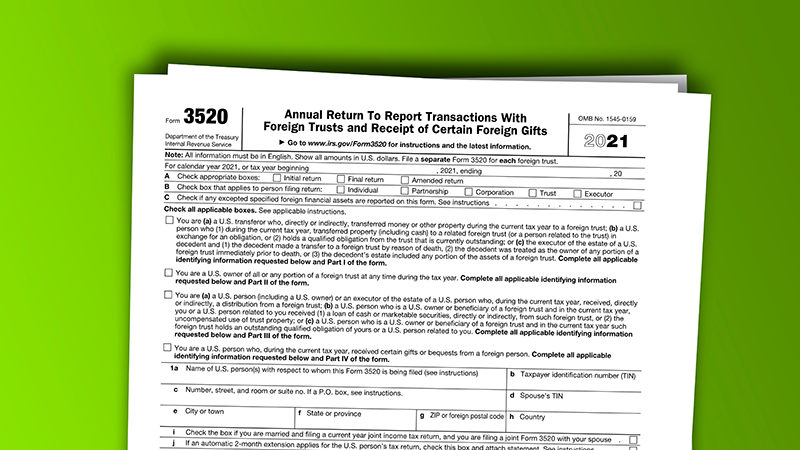IRS Form 8621: Reporting Your Passive Foreign Investment Company Investments
When investing abroad, U.S. taxpayers encounter numerous reporting obligations and tax challenges. One of the most complex forms associated with...
11 min read
 H&CO
Oct 14, 2024 1:47:56 PM
H&CO
Oct 14, 2024 1:47:56 PM

Navigating the complexities of international tax compliance can be overwhelming, especially when it comes to owning or having interests in foreign partnerships. For U.S. persons involved in foreign partnerships, one of the most crucial forms they need to file is IRS Form 8865. This 8865 form is significant due to its complexities and the various categories of filers associated with it, making it essential for U.S. taxpayers to maintain accurate records and meet detailed reporting requirements to ensure compliance.
Failure to comply with the filing requirements of Form 8865 can result in significant penalties and create substantial tax liabilities. In this article, we’ll break down everything you need to know about IRS Form 8865, its purpose, who must file it, the necessary schedules, and key considerations to ensure full compliance with U.S. tax laws.
|
INDEX |
IRS Form 8865, titled Return of U.S. Persons For Certain Foreign Partnerships, is a reporting requirement for U.S. persons (individuals, corporations, trusts, and partnerships) who have a significant interest in or control over a foreign partnership. The form is designed to provide the Internal Revenue Service (IRS) with detailed information about the U.S. person’s involvement in the foreign partnership, including income, distributions, ownership interests, and transactions.
U.S. partners in a foreign partnership must file Form 8865 when their partnership is classified as a controlled foreign corporation, emphasizing the ownership structure and the forms that need to be filed for compliance.
Form 8865 also helps the IRS track cross-border investments and ensure that U.S. persons are properly reporting income from foreign sources and complying with international tax regulations. The form is related to Sections 6038, 6038B, and 6046A of the Internal Revenue Code (IRC), which focus on reporting transfers to and from foreign partnerships, controlled foreign partnerships, and significant changes in ownership.
Form 8865 filing requirements apply to U.S. persons who meet specific ownership thresholds or transaction thresholds with foreign partnerships. There are four distinct categories of filers, each with its own filing requirements. Understanding which category you fall into is critical in determining your filing obligations.
Exceptions reporting relating to specific scenarios where U.S. partners in foreign partnerships are exempt from certain filing requirements, particularly with the IRS Form 8865, include situations involving constructive ownership and multiple Category 1 filers. These exceptions highlight conditions under which certain partners may not need to report due to various exceptions outlined in the tax regulations.
A Category 1 filer is a U.S. person who owns more than a 50% interest in the foreign partnership at any time during the partnership’s tax year. Control can be direct, indirect, direct ownership, or constructive (via family members or entities in which the filer has an interest). In some cases, more than one U.S. person may be a Category 1 filer for the same partnership.
What to File: Category 1 filers must complete the entire Form 8865, including all applicable schedules, such as Schedule A (Constructive Ownership of Partnership Interest), Schedule B (Income Statement), Schedule K (Partners’ Distributive Share Items), Schedule K-1 (Partners’ Share of Income), and Schedule L (Balance Sheet).
Category 2 filers include U.S. persons who own at least 10% of a foreign partnership during the year, provided the partnership is controlled by U.S. persons. However, if there is already a Category 1 filer for the partnership, no Category 2 filer is required to submit Form 8865.
What to File: Category 2 filers need to file the core identifying information on Form 8865 along with specific schedules, including Schedule A (Constructive Ownership) and Schedule K-1 (for their own share of the partnership).
Category 3 filers are U.S. persons who contribute property to a foreign partnership in exchange for a partnership interest. This category also applies to those whose total property contributions exceed $100,000 in value over 12 months or who directly or constructively own at least 10% of the foreign partnership after the transfer.
What to File: Category 3 filers must complete the relevant sections of Form 8865, particularly Schedule O (Transfer of Property to a Foreign Partnership). This schedule details the contributed property and any gain recognized upon contribution.
Category 4 filers include U.S. persons who experience a reportable event, such as acquiring, disposing of, or significantly changing their proportional interest in a foreign partnership. Reportable events include acquiring at least a 10% interest in the partnership or increasing or decreasing your proportional interest by at least 10%.
What to File: Category 4 filers must complete Schedule P (Acquisitions, Dispositions, and Changes of Interests in a Foreign Partnership) to document the change in their partnership interest.
Form 8865 should be submitted as an attachment to your U.S. income tax return (or relevant partnership or exempt organization return). If you file your tax return electronically, Form 8865 will be included in that submission. For paper returns, they must be attached and mailed to the IRS along with your tax return, following the address guidelines applicable to your specific return type.
The deadline for filing Form 8865 coincides with the due date of your income tax return, including any extensions. Typically, this means Form 8865 is due by April 15, with an extended deadline of October 15 if a filing extension is granted. It is crucial to meet this deadline to avoid potential penalties for late filing.
Failing to file Form 8865 can lead to substantial penalties. The standard penalty is $10,000 per year, per foreign partnership, for not providing the required information. If the failure continues for more than 90 days after an IRS notice is issued, an additional penalty of $10,000 can be applied for each 30 days, up to a maximum of $50,000 per form. Further penalties, such as reductions in foreign tax credits, may also apply, and penalties for intentional disregard can be even higher. Monetary fines can be significant and should not be overlooked.
Understanding how ownership thresholds work is essential when determining whether you must file Form 8865. Direct ownership means holding an interest in a foreign partnership, while constructive ownership extends to indirect interests held through family members or related entities.
Constructive ownership rules can be complex, as they look at relationships with family members, such as spouses, parents, and children, as well as other entities, such as corporations and trusts. Ensuring that all forms of ownership are properly reported will help avoid penalties.
One of the key responsibilities of Category 3 filers is reporting the transfer of property to foreign partnerships. If the property has built-in gain, special attention must be paid to Section 721(c), which may require the recognition of gain unless the gain deferral method is applied.
It is important to consult with a tax advisor to determine if the remedial allocation method under Section 704(c) applies and whether additional schedules such as Schedule G and H need to be filed to comply with the gain deferral method.

In some cases, multiple U.S. partners may be required to file Form 8865 for the same foreign partnership. However, only one partner can file on behalf of the group under certain conditions. All partners must coordinate to ensure the correct partner files the form and that all necessary information, including details about related entities, is included.
Capital gains and losses must be carefully reported, especially if the partnership has distributed or sold assets during the tax year. Schedule D (Form 1065) should be used to report capital gains and losses. Misreporting or omitting these items can trigger penalties and audits.
For partnerships with international tax relevance, Schedules K-2 and K-3 are essential for correctly reporting income, credits, and deductions related to foreign transactions. Incorrect or incomplete reporting on these schedules may result in penalties or foreign tax credit disallowances.
Form 8865 is essential for U.S. taxpayers with interests in foreign partnerships, especially when dealing with international tax obligations. Filing Form 8865 is a crucial part of fulfilling these obligations, as it requires U.S. persons to report their share of foreign income and taxes, including those paid by the foreign partnership. Accurate reporting through schedules K-2 and K-3 on Form 8865 is crucial for determining how much foreign tax has been paid and how that can offset U.S. tax obligations.
Foreign tax credits (FTCs) allow U.S. taxpayers to reduce their U.S. tax liability by the amount of taxes paid to foreign governments, helping to avoid double taxation. Form 8865 captures these details and ensures that eligible partners can claim the appropriate foreign tax credits on their U.S. returns. The more accurately the foreign taxes and income are reported, the easier it becomes to maximize the credit benefits.
Completing Form 8865 correctly not only ensures compliance but also plays a key role in managing foreign tax liabilities. Errors or omissions can result in penalties or missed opportunities to claim foreign tax credits, which can increase your overall tax burden. Proper filing is critical to both avoiding double taxation and minimizing U.S. tax liability for foreign partnership interests.
Know When You Need to File
Form 8865 is required if you're a U.S. person involved in a foreign partnership, whether through ownership, control, or property transfers. Be sure to check if your situation qualifies to avoid non-compliance penalties.
Understand the Categories of Filers
There are four categories of filers for Form 8865, based on the level of ownership and type of transactions with the foreign partnership. Knowing which category applies to you is essential for filing the correct schedules and information.
Attach Form 8865 to Your Tax Return
Form 8865 must be attached to your U.S. income tax return or other applicable returns, like partnership or exempt organization returns. Be sure to include it when you submit your tax return to avoid filing penalties.
Pay Attention to Schedule Requirements
Depending on your category, you might need to file several schedules along with Form 8865, including Schedules K-1, K-2, K-3, and others. Make sure you complete the required schedules specific to your filing category.
Filing Deadlines Align with Tax Returns
The due date for Form 8865 is the same as the due date for your tax return, generally April 15th, unless you file for an extension, which moves the deadline to October 15th. Missing this deadline can lead to penalties, so mark your calendar.
Penalties Can Add Up Quickly
The base penalty for failing to file Form 8865 is $10,000, with potential additional penalties if you don’t correct the issue within 90 days of receiving an IRS notice. Don’t let this slip through the cracks, as penalties can escalate to a maximum of $50,000.
Understand the Statute of Limitations
If Form 8865 is not filed, the statute of limitations for the entire tax return remains open indefinitely. This means the IRS can audit your return at any time if you fail to file the required form.
Consider Electronic Filing
Although not all forms can be filed electronically, attaching Form 8865 to an electronically filed tax return can be a convenient way to ensure it’s filed correctly and on time, reducing the risk of penalties.
Keep Detailed Records
Accurate and comprehensive records are key when dealing with foreign partnerships. You'll need to report specific financial transactions and ownership details on Form 8865, so maintaining good records will make the filing process smoother and help ensure compliance.
Consult a Tax Professional for Complex Situations
Foreign partnerships and the corresponding tax filings can be complex. If you're unsure of how to proceed, consulting a tax professional can help you navigate the process and avoid costly mistakes.
IRS Form 8865 is a vital requirement for U.S. persons with interests in foreign partnerships. By understanding your filing category, completing the appropriate schedules, and ensuring timely submission, you can stay compliant with U.S. tax laws and avoid penalties.
If you’re unsure about your filing requirements or need assistance with Form 8865, H&CO is here to help. Our team of international tax experts is ready to guide you through the complexities of foreign partnership reporting and provide tailored solutions for your unique situation.
At H&CO, we understand that international tax compliance can be challenging, especially for U.S. persons involved in foreign partnerships. Our team of experienced international tax professionals is dedicated to helping you navigate the complex requirements of IRS Form 8865 and ensure that your foreign partnership reporting is accurate and timely.
With offices in the US in Miami, Coral Gables, Aventura, Fort Lauderdale, Orlando, Melbourne, and Tampa as well as offices in over 29 countries, our CPAs and International Tax Advisors are readily available to assist you with all your income tax planning, tax preparation and IRS representation needs. To learn more about our accounting firm services take a look at our individual tax services, business tax services, international tax services, expatriate tax services, SAP Business One, entity management, human capital, and audit and assurance services.
Form 8865 Preparation and Filing: We assist clients in determining their filing obligations and preparing the necessary schedules to meet all IRS requirements.
International Tax Planning: We help structure your foreign partnership interests to minimize tax liabilities and optimize foreign tax credits.
Compliance with Section 721(c) and Gain Deferral Methods: Our experts can guide you through the rules related to Section 721(c) property transfers, ensuring compliance with gain deferral methods.
Penalty Mitigation: If you have missed filing deadlines or made errors on previously filed Form 8865s, we can help correct these issues and work with the IRS to mitigate penalties.
Form 8865 is used by U.S. persons who have certain ownership or control over foreign partnerships. It is required to report information about the foreign partnership’s income, gains, losses, deductions, and transactions. The form helps the IRS track cross-border activities and ensures compliance with U.S. tax laws.
Form 5471 is used to report U.S. persons' interests in foreign corporations, while Form 8865 is for reporting interests in foreign partnerships. Both forms are designed to ensure U.S. taxpayers report foreign income and comply with tax regulations, but they apply to different types of entities.
Yes, Form 8865 can be filed electronically if it is submitted as an attachment to a taxpayer’s electronically filed income tax return. This ensures faster processing and helps avoid delays that can occur with paper filings.
Schedule G of Form 8865 is used to report information about the gain deferral method under Section 721(c). It applies to U.S. transferors who contribute property to a foreign partnership and defer recognizing any gains through this method.
U.S. persons who own or have control over a foreign partnership, or who engage in certain transactions with a foreign partnership, must file Form 8865. This includes those who meet specific ownership thresholds or contribute property to a foreign partnership.
The penalty for failing to file Form 8865 is $10,000 per foreign partnership per year, with additional penalties for continued failure to file, up to $50,000. Additional consequences include the potential loss of foreign tax credits and further penalties for significant understatements.
The statute of limitations for Form 8865 typically begins when the form is filed. If the form is not filed, the statute of limitations may remain open indefinitely, meaning the IRS can audit the taxpayer’s returns for that year without restriction.
Form 8865 consists of various schedules that provide detailed reporting on the activities of the foreign partnership, including income, balance sheets, and transactions. The schedules required will depend on the filer’s category. Below are some of the most important schedules that help assess the financial position of the partnership:
Schedule A is used to report the direct or constructive ownership of interests in a foreign partnership. Constructive ownership applies when an individual is considered to own shares indirectly through family members or entities.
Schedule B is required for Category 1 filers and provides a comprehensive income statement for the partnership, including gross income, deductions, and net income or loss from trade or business activities. This schedule helps the IRS evaluate the partnership’s overall financial performance.
Schedule K: A summary of all partners’ distributive shares of income, deductions, and credits, required for Category 1 filers.
Schedule K-1: Provides each partner with a detailed breakdown of their share of the partnership’s income, deductions, and credits. Category 1 and 2 filers must complete Schedule K-1 for all partners holding direct interests.
Schedules K-2 and K-3 provide important details regarding international tax items, such as foreign tax credits and deductions. These schedules are critical for reporting the international tax implications of a foreign partnership’s activities. They replace the previous reporting method on Schedule K and K-1 for foreign transactions.
Schedule L requires the foreign partnership to provide a balance sheet that reflects its financial position at the beginning and end of the year. This schedule must adhere to U.S. Generally Accepted Accounting Principles (GAAP) and is required for Category 1 filers.
Schedule M-1: Reconciles the income or loss per book with the income or loss reported on Form 8865.
Schedule M-2: Analyze the changes in partners’ capital accounts throughout the year.
Schedule N is required for Category 1 and 2 filers and documents transactions between the foreign partnership and its partners or related entities. This schedule is crucial for identifying potential conflicts of interest or related-party transactions.
Schedule O is used by Category 3 filers to report the transfer of property to a foreign partnership. It includes details about the type of property transferred, its fair market value (FMV), and the adjusted basis. This is important for tracking gains and losses on property transfers.
Schedule P is required for Category 4 filers who have had significant changes in their foreign partnership interests. This schedule tracks acquisitions, dispositions, or changes in a partner’s proportional interest.

When investing abroad, U.S. taxpayers encounter numerous reporting obligations and tax challenges. One of the most complex forms associated with...

If you’ve received a gift from certain foreign persons, a foreign trust, or a foreign corporation, it’s crucial to understand IRS reporting...

In today’s increasingly globalized business environment, U.S. investors and companies often hold ownership stakes in foreign corporations. The...